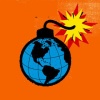E-Wave In Words
#1

Posted 02 November 2007 - 08:05 PM
#2

Posted 02 November 2007 - 10:36 PM
I found the following description of the characteristics of the 5 waves of an impulse.
Since there are so many experts on wave counting here I thought this would be of interest.
"Wave 1: First waves are rarely recognized at their inception. When the first wave of a new bull market begins, the fundamental news is just about universally negative. The previous trend is considered still strongly in force. Fundamental analysts continue to revise their earnings estimates lower; most likely, the economy does not look strong either. Sentiment surveys are decidedly bearish, put options are in vogue, and implied volatility in the options market is high. Volume might increase a bit as prices rise, but not by enough to alert many technical analysts.
Wave 2: Wave two corrects wave one, but can never extend beyond the starting point of wave one. Typically, the news is still bad. As the markets retest the prior low, bearish sentiment quickly builds, and "the crowd" haughtily reminds all that the bear market is still deeply ensconced. Still, some positive signs appear for those who are looking: volume should be lower during wave two than during wave one, prices usually do not retrace more than 61.8% (see Fibonacci section below) of the wave one gains, and prices should fall in a three wave pattern.
Wave 3: Wave three is usually the largest and most powerful wave in a trend (although some research suggests that in commodity markets, wave five is the largest). The news is now positive and fundamental analysts start to raise earnings estimates. Prices rise quickly, and corrects are short-lived and shallow. Anybody looking to "get in on a pull-back" is likely going to miss the boat. As wave three starts, news is probably still bearish, and most market players remain negative. But, by the midpoint of wave three, "the crowd" will often now be on board with the new bullish trend. Wave three often extends wave one by a ratio of 1.618 : 1.
Wave 4: Fourth waves are typically clearly corrective. Prices may meander in a sideways pattern for an extended period, with wave four typically retracing less than 38.2% of wave three. Volume is well below than that of wave three. This is a good place to buy a pull back, if you understand the potential for wave 5 ahead. However, possibly the single most distinguishing feature of fourth waves is that they are often very difficult to count.
Wave 5: The fifth wave is the final leg of a five wave move. The news is now almost universally positive and everybody is bullish. Unfortunately, this is the point when many "average investors" finally buy in, right before the top. Volume is lower in wave five than in wave three, and many technical momentum indicators will start showing divergences (prices reach a new high, the indicator does not reach a new peak). At the end of a major bull market, bears may very well be ridiculed (recall how those calling for a top in the stock market during 2000 were received)."
Just as a side note, I notice that the majority of the E-wave counts I see here show us in a perpetual 5th wave that is always just moments from THE top for the ages. But the description above says that in a 5th wave "The news is now almost universally positive and everybody is bullish"... Well I'm not sure what planet you folks are from but here on Earth I am hard pressed to find "universally positive news" right now. If you think the news is universally positive right now I would submit that you don't have a TV, Radio, can't read, don't have internet access, and are living under a rock on the planet Mars...
Wave 3 cannot be the shortest is an immutable and basic rule of e-wave. If that rule is argued upon on this baord, there's no point talking about other things like importance of structure, sentiment, alternation, extension etc.
E-wave on most boards is adjusted to pick tops be it a wave 5 top, wave B top or wave C top. Have you ever seen any wave count trying to pick a bottom of any sort ? Any down move automatically becomes wave 3 down of some degree.
Edited by NAV, 02 November 2007 - 10:39 PM.
#3

Posted 02 November 2007 - 11:20 PM
#4

Posted 03 November 2007 - 12:13 AM
Although I fully understand the intentional focus on why this post was made, the descriptions given here by the author not only have many inaccuracies, but it's also incoherent as to the premise of what makes Elliott Wave analysis as unique as it is. To me it was like reading a book report that was assigned a month ago and hurriedly put together the night before in hopes of fooling the teacher in getting a passing grade.Well I'm not sure what planet you folks are from, but here on Earth I am hard pressed to find "universally positive news" right now.
Fib
Better to ignore me than abhor me.
“Wise men don't need advice. Fools won't take it” - Benjamin Franklin
"Beware of false knowledge; it is more dangerous than ignorance" - George Bernard Shaw
Demagogue: A leader who makes use of popular prejudices, false claims and promises in order to gain power.
Technical Watch Subscriptions














